Finance Report: MFRD Analysis of Sources, Planning, and Statements
VerifiedAdded on 2020/07/22
|21
|4810
|55
Report
AI Summary
This report delves into the financial aspects of a business, exploring various sources of finance such as equity, debentures, bank loans, venture capital, and retained earnings, along with their implications on a firm's financial and legal aspects. It evaluates the cost of different financing options and emphasizes the importance of financial planning for prudent cash management. The report analyzes the information needs of internal and external decision-makers, including stakeholders and suppliers, and examines the impact of different sources of finance on financial statements. It further analyzes budgets, unit cost calculations, and project viability, including the calculation of payback period, ARR, NPV, and IRR. Finally, it compares financial statements and performs ratio analysis to assess the performance of Marks and Spencer, offering insights into its financial health and decision-making processes.

MFRD
Paraphrase This Document
Need a fresh take? Get an instant paraphrase of this document with our AI Paraphraser

TABLE OF CONTENTS
INTRODUCTION...........................................................................................................................1
TASK 1............................................................................................................................................1
1.1 Sources of finance available to business firms.................................................................1
1.2 Implications of sources of finance....................................................................................2
1.3 Evaluating appropriate source of finance for the firm......................................................4
TASK 2............................................................................................................................................4
2.1 Cost of varied sources of finance...........................................................................................4
2.2 Importance of financial planning...........................................................................................5
2.3 Analysis of the information needs of internal and external decision maker..........................5
2.4 Impact of various sources of finance upon the financial statement.......................................5
TASK 3............................................................................................................................................6
3.1 Analysis of budget and important decisions..........................................................................6
3.2 Explain the calculation of unit cost and pricing decisions....................................................7
3.3 Viability of project.................................................................................................................8
TASK 4..........................................................................................................................................10
4.1 Important financial statements prepared by Marks and Spencer.........................................10
4.2 Comparison of format of financial statemetnts...................................................................11
financial statements...................................................................................................................11
4.3 Ratio analysis.......................................................................................................................15
CONCLUSION..............................................................................................................................17
Table 1Calculation of Payback period.............................................................................................8
Table 2Calculation of ARR.............................................................................................................9
Table 3Calculation of NPV.............................................................................................................9
Table 4Calculation of IRR...............................................................................................................9
INTRODUCTION...........................................................................................................................1
TASK 1............................................................................................................................................1
1.1 Sources of finance available to business firms.................................................................1
1.2 Implications of sources of finance....................................................................................2
1.3 Evaluating appropriate source of finance for the firm......................................................4
TASK 2............................................................................................................................................4
2.1 Cost of varied sources of finance...........................................................................................4
2.2 Importance of financial planning...........................................................................................5
2.3 Analysis of the information needs of internal and external decision maker..........................5
2.4 Impact of various sources of finance upon the financial statement.......................................5
TASK 3............................................................................................................................................6
3.1 Analysis of budget and important decisions..........................................................................6
3.2 Explain the calculation of unit cost and pricing decisions....................................................7
3.3 Viability of project.................................................................................................................8
TASK 4..........................................................................................................................................10
4.1 Important financial statements prepared by Marks and Spencer.........................................10
4.2 Comparison of format of financial statemetnts...................................................................11
financial statements...................................................................................................................11
4.3 Ratio analysis.......................................................................................................................15
CONCLUSION..............................................................................................................................17
Table 1Calculation of Payback period.............................................................................................8
Table 2Calculation of ARR.............................................................................................................9
Table 3Calculation of NPV.............................................................................................................9
Table 4Calculation of IRR...............................................................................................................9
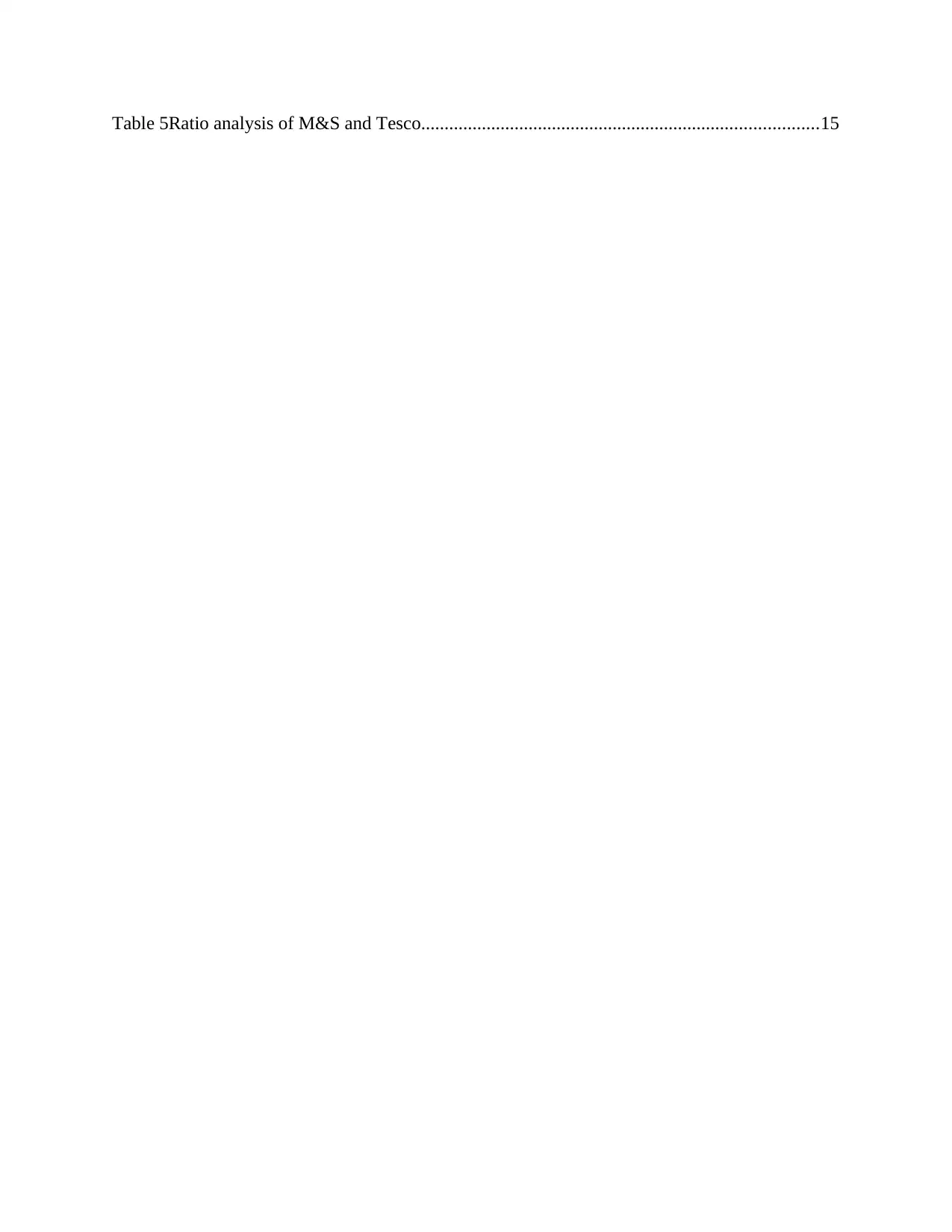
Table 5Ratio analysis of M&S and Tesco.....................................................................................15
⊘ This is a preview!⊘
Do you want full access?
Subscribe today to unlock all pages.

Trusted by 1+ million students worldwide

INTRODUCTION
Finance is the one of branch of business management that matter a lot for the business
firm. In the present research study sources of finance are explained and their implications for the
firm are discussed in detail. In middle part of the reprot, cash budget and project evaluation is
done. On the basis of obtained results most profitable project is selected for the business firm. At
end of thre report, ratio analysis is done and on that basis performance of the firm is acessed and
funancial statements are also compared and differentiate in respect to sole trader, partnership and
company.
TASK 1
1.1 Sources of finance available to business firms
There are number of sources of finance that are available to the business firms. All these
sources of finannce have some merits and demerits. It become inevitable for the firm to ensure
that it is raising funds from appropriate source of finance. Some of the common sources of
finance that are available to Marks and Spencer are given below.
External source of finance
Equity: Equity is commonly used as a source to fund project that required heavy capital
investment (Caglayan and Demir, 2014). This source of finance is usually used by the
business firms when they want to make huge capital investment in the business to
expand it at rapid pace. Marks and Spencer can issue shares in stock market and can
invest proceed amount to develop its own infrastructure and opening new branches across
globe.
Debenture: It is a variant of debt and similar to bank loan. Only difference between
debenture and bank loan is that in case of former one debt is taken from general public at
specific interest rate but in case of latter one financial institute give loan to the business
firm. large corporates that have good reputation usually issue debentures on which
investment is made by the mutual fund and other firms.
Bank loan: Bank loan is the commonly available source of finance that is available to
Marks and Spencer. Under this simply by mortgaging some property target amount of
loan is raised from financial institute and then same is invested in business. From earned
revenue principal and interest amount is paid by firm to bank.
1 | P a g e
Finance is the one of branch of business management that matter a lot for the business
firm. In the present research study sources of finance are explained and their implications for the
firm are discussed in detail. In middle part of the reprot, cash budget and project evaluation is
done. On the basis of obtained results most profitable project is selected for the business firm. At
end of thre report, ratio analysis is done and on that basis performance of the firm is acessed and
funancial statements are also compared and differentiate in respect to sole trader, partnership and
company.
TASK 1
1.1 Sources of finance available to business firms
There are number of sources of finance that are available to the business firms. All these
sources of finannce have some merits and demerits. It become inevitable for the firm to ensure
that it is raising funds from appropriate source of finance. Some of the common sources of
finance that are available to Marks and Spencer are given below.
External source of finance
Equity: Equity is commonly used as a source to fund project that required heavy capital
investment (Caglayan and Demir, 2014). This source of finance is usually used by the
business firms when they want to make huge capital investment in the business to
expand it at rapid pace. Marks and Spencer can issue shares in stock market and can
invest proceed amount to develop its own infrastructure and opening new branches across
globe.
Debenture: It is a variant of debt and similar to bank loan. Only difference between
debenture and bank loan is that in case of former one debt is taken from general public at
specific interest rate but in case of latter one financial institute give loan to the business
firm. large corporates that have good reputation usually issue debentures on which
investment is made by the mutual fund and other firms.
Bank loan: Bank loan is the commonly available source of finance that is available to
Marks and Spencer. Under this simply by mortgaging some property target amount of
loan is raised from financial institute and then same is invested in business. From earned
revenue principal and interest amount is paid by firm to bank.
1 | P a g e
Paraphrase This Document
Need a fresh take? Get an instant paraphrase of this document with our AI Paraphraser
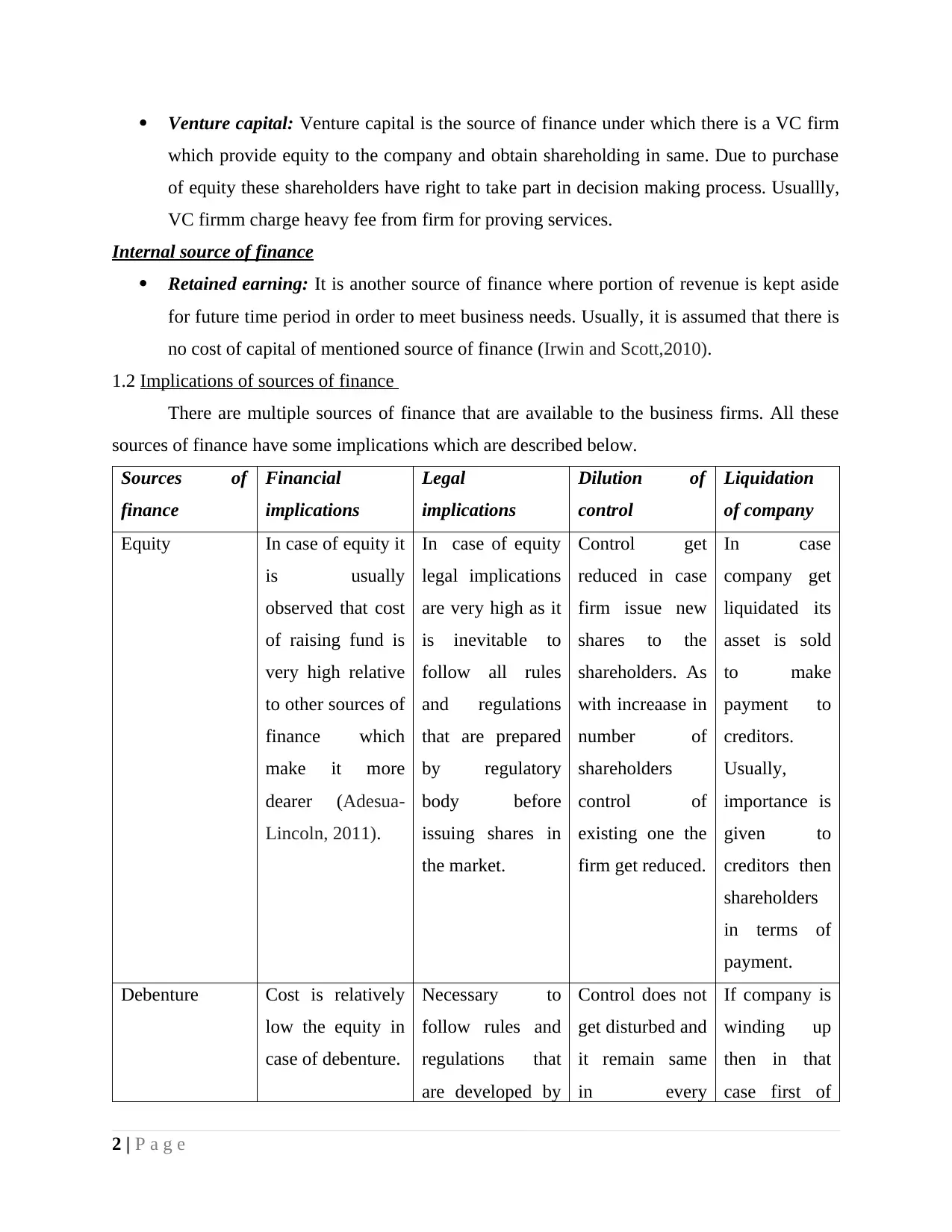
Venture capital: Venture capital is the source of finance under which there is a VC firm
which provide equity to the company and obtain shareholding in same. Due to purchase
of equity these shareholders have right to take part in decision making process. Usuallly,
VC firmm charge heavy fee from firm for proving services.
Internal source of finance
Retained earning: It is another source of finance where portion of revenue is kept aside
for future time period in order to meet business needs. Usually, it is assumed that there is
no cost of capital of mentioned source of finance (Irwin and Scott,2010).
1.2 Implications of sources of finance
There are multiple sources of finance that are available to the business firms. All these
sources of finance have some implications which are described below.
Sources of
finance
Financial
implications
Legal
implications
Dilution of
control
Liquidation
of company
Equity In case of equity it
is usually
observed that cost
of raising fund is
very high relative
to other sources of
finance which
make it more
dearer (Adesua-
Lincoln, 2011).
In case of equity
legal implications
are very high as it
is inevitable to
follow all rules
and regulations
that are prepared
by regulatory
body before
issuing shares in
the market.
Control get
reduced in case
firm issue new
shares to the
shareholders. As
with increaase in
number of
shareholders
control of
existing one the
firm get reduced.
In case
company get
liquidated its
asset is sold
to make
payment to
creditors.
Usually,
importance is
given to
creditors then
shareholders
in terms of
payment.
Debenture Cost is relatively
low the equity in
case of debenture.
Necessary to
follow rules and
regulations that
are developed by
Control does not
get disturbed and
it remain same
in every
If company is
winding up
then in that
case first of
2 | P a g e
which provide equity to the company and obtain shareholding in same. Due to purchase
of equity these shareholders have right to take part in decision making process. Usuallly,
VC firmm charge heavy fee from firm for proving services.
Internal source of finance
Retained earning: It is another source of finance where portion of revenue is kept aside
for future time period in order to meet business needs. Usually, it is assumed that there is
no cost of capital of mentioned source of finance (Irwin and Scott,2010).
1.2 Implications of sources of finance
There are multiple sources of finance that are available to the business firms. All these
sources of finance have some implications which are described below.
Sources of
finance
Financial
implications
Legal
implications
Dilution of
control
Liquidation
of company
Equity In case of equity it
is usually
observed that cost
of raising fund is
very high relative
to other sources of
finance which
make it more
dearer (Adesua-
Lincoln, 2011).
In case of equity
legal implications
are very high as it
is inevitable to
follow all rules
and regulations
that are prepared
by regulatory
body before
issuing shares in
the market.
Control get
reduced in case
firm issue new
shares to the
shareholders. As
with increaase in
number of
shareholders
control of
existing one the
firm get reduced.
In case
company get
liquidated its
asset is sold
to make
payment to
creditors.
Usually,
importance is
given to
creditors then
shareholders
in terms of
payment.
Debenture Cost is relatively
low the equity in
case of debenture.
Necessary to
follow rules and
regulations that
are developed by
Control does not
get disturbed and
it remain same
in every
If company is
winding up
then in that
case first of
2 | P a g e

relevant govrning
body. In case of
failure to do so
may results in
negatue
consequence in
business.
situation. all its assets
are sold in the
market and by
using same
payment is
made to the
debenture
holders. If
any amount
remain then
same is used
to make
payment to
shareholders.
Bank loan In case of bank
loan like
debenture there is
loss cost of source
of finance. Due to
this reason it is
preffered by most
of the business
firms (Duchin,
Ozbas. and
Sensoy, 2010).
In case of bank
loan financial
institutes have
their own standard
that they followed
for giving loan to
the business firms.
As per rules in
case if Marks and
Spencer failed to
given loan amount
on time strict
action can be
taken by bank
against it.
Like debenture
in case of bank
loan also control
remain
unchanged.
In case of
bank loan
first of all
relevant
amount is
paid to bank
and then
remaining
proceeds are
used to pay
shareholders.
Venture capital VC firms have
huge control on
Terms and
conditions are
Control of
existing
In case of
liquidation
3 | P a g e
body. In case of
failure to do so
may results in
negatue
consequence in
business.
situation. all its assets
are sold in the
market and by
using same
payment is
made to the
debenture
holders. If
any amount
remain then
same is used
to make
payment to
shareholders.
Bank loan In case of bank
loan like
debenture there is
loss cost of source
of finance. Due to
this reason it is
preffered by most
of the business
firms (Duchin,
Ozbas. and
Sensoy, 2010).
In case of bank
loan financial
institutes have
their own standard
that they followed
for giving loan to
the business firms.
As per rules in
case if Marks and
Spencer failed to
given loan amount
on time strict
action can be
taken by bank
against it.
Like debenture
in case of bank
loan also control
remain
unchanged.
In case of
bank loan
first of all
relevant
amount is
paid to bank
and then
remaining
proceeds are
used to pay
shareholders.
Venture capital VC firms have
huge control on
Terms and
conditions are
Control of
existing
In case of
liquidation
3 | P a g e
⊘ This is a preview!⊘
Do you want full access?
Subscribe today to unlock all pages.

Trusted by 1+ million students worldwide

the firm and due
to this reason
receive huge
amount as
dividend and
seating fee from
the business firms.
Thus, cost of
venture capital is
relatively higher
then equity.
determind by the
company and
venture capital
firm and
accordingly both
firms need to
perform their
operations
(Embrechts,,
Klüppelberg. and
Mikosch, 2013).
shareholders
heavily get
affected because
new
shareholders
make purchase
of shares and
due to this
reason they will
also participate
in decision
making process
of an
organization.
also after give
amount to
creditors
payment is
made to
venture
capital firm.
Retained earning Opportunity cost
is consdiered as
cost of retained
earning.
There are no legal
implications of
retained earning
for the firm.
Control remain
unchanged.
In case of
liquidation no
implications.
1.3 Evaluating appropriate source of finance for the firm
Out of all these sources of finance equity is considered as one of best alternative because
by using mentioned source of finance firm can adjust its cost of capital and in case it face loss in
business can avoid cost of capital. Debt is not considered as appropriate source because if debt
increases consistently its burdent inceased on busiines firm and this negatively affect its
performance. Venture capital can not be considered as best option because under this large
portion of shareholding is given to relevant firm due to which its real owners find themselves
unable to make decisions with full freedom (Finance and Network, 2013). Hence, this is one of
major limitation of venture capital and due to this reason it is not selected for the business firm.
Retained earning is also considered best for the business firm as its cost is negligible and due to
this reason it is assumed appropriate source of finance.
4 | P a g e
to this reason
receive huge
amount as
dividend and
seating fee from
the business firms.
Thus, cost of
venture capital is
relatively higher
then equity.
determind by the
company and
venture capital
firm and
accordingly both
firms need to
perform their
operations
(Embrechts,,
Klüppelberg. and
Mikosch, 2013).
shareholders
heavily get
affected because
new
shareholders
make purchase
of shares and
due to this
reason they will
also participate
in decision
making process
of an
organization.
also after give
amount to
creditors
payment is
made to
venture
capital firm.
Retained earning Opportunity cost
is consdiered as
cost of retained
earning.
There are no legal
implications of
retained earning
for the firm.
Control remain
unchanged.
In case of
liquidation no
implications.
1.3 Evaluating appropriate source of finance for the firm
Out of all these sources of finance equity is considered as one of best alternative because
by using mentioned source of finance firm can adjust its cost of capital and in case it face loss in
business can avoid cost of capital. Debt is not considered as appropriate source because if debt
increases consistently its burdent inceased on busiines firm and this negatively affect its
performance. Venture capital can not be considered as best option because under this large
portion of shareholding is given to relevant firm due to which its real owners find themselves
unable to make decisions with full freedom (Finance and Network, 2013). Hence, this is one of
major limitation of venture capital and due to this reason it is not selected for the business firm.
Retained earning is also considered best for the business firm as its cost is negligible and due to
this reason it is assumed appropriate source of finance.
4 | P a g e
Paraphrase This Document
Need a fresh take? Get an instant paraphrase of this document with our AI Paraphraser
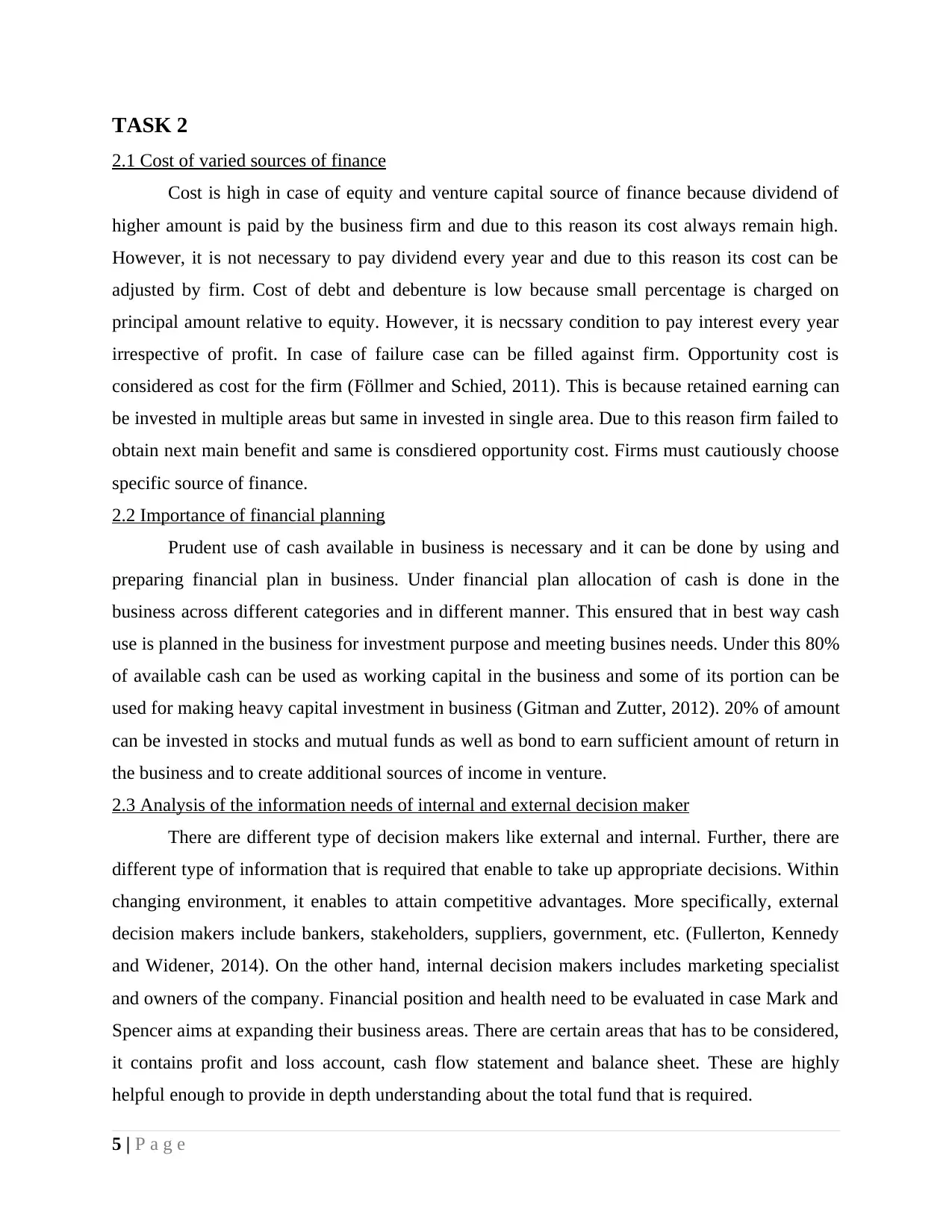
TASK 2
2.1 Cost of varied sources of finance
Cost is high in case of equity and venture capital source of finance because dividend of
higher amount is paid by the business firm and due to this reason its cost always remain high.
However, it is not necessary to pay dividend every year and due to this reason its cost can be
adjusted by firm. Cost of debt and debenture is low because small percentage is charged on
principal amount relative to equity. However, it is necssary condition to pay interest every year
irrespective of profit. In case of failure case can be filled against firm. Opportunity cost is
considered as cost for the firm (Föllmer and Schied, 2011). This is because retained earning can
be invested in multiple areas but same in invested in single area. Due to this reason firm failed to
obtain next main benefit and same is consdiered opportunity cost. Firms must cautiously choose
specific source of finance.
2.2 Importance of financial planning
Prudent use of cash available in business is necessary and it can be done by using and
preparing financial plan in business. Under financial plan allocation of cash is done in the
business across different categories and in different manner. This ensured that in best way cash
use is planned in the business for investment purpose and meeting busines needs. Under this 80%
of available cash can be used as working capital in the business and some of its portion can be
used for making heavy capital investment in business (Gitman and Zutter, 2012). 20% of amount
can be invested in stocks and mutual funds as well as bond to earn sufficient amount of return in
the business and to create additional sources of income in venture.
2.3 Analysis of the information needs of internal and external decision maker
There are different type of decision makers like external and internal. Further, there are
different type of information that is required that enable to take up appropriate decisions. Within
changing environment, it enables to attain competitive advantages. More specifically, external
decision makers include bankers, stakeholders, suppliers, government, etc. (Fullerton, Kennedy
and Widener, 2014). On the other hand, internal decision makers includes marketing specialist
and owners of the company. Financial position and health need to be evaluated in case Mark and
Spencer aims at expanding their business areas. There are certain areas that has to be considered,
it contains profit and loss account, cash flow statement and balance sheet. These are highly
helpful enough to provide in depth understanding about the total fund that is required.
5 | P a g e
2.1 Cost of varied sources of finance
Cost is high in case of equity and venture capital source of finance because dividend of
higher amount is paid by the business firm and due to this reason its cost always remain high.
However, it is not necessary to pay dividend every year and due to this reason its cost can be
adjusted by firm. Cost of debt and debenture is low because small percentage is charged on
principal amount relative to equity. However, it is necssary condition to pay interest every year
irrespective of profit. In case of failure case can be filled against firm. Opportunity cost is
considered as cost for the firm (Föllmer and Schied, 2011). This is because retained earning can
be invested in multiple areas but same in invested in single area. Due to this reason firm failed to
obtain next main benefit and same is consdiered opportunity cost. Firms must cautiously choose
specific source of finance.
2.2 Importance of financial planning
Prudent use of cash available in business is necessary and it can be done by using and
preparing financial plan in business. Under financial plan allocation of cash is done in the
business across different categories and in different manner. This ensured that in best way cash
use is planned in the business for investment purpose and meeting busines needs. Under this 80%
of available cash can be used as working capital in the business and some of its portion can be
used for making heavy capital investment in business (Gitman and Zutter, 2012). 20% of amount
can be invested in stocks and mutual funds as well as bond to earn sufficient amount of return in
the business and to create additional sources of income in venture.
2.3 Analysis of the information needs of internal and external decision maker
There are different type of decision makers like external and internal. Further, there are
different type of information that is required that enable to take up appropriate decisions. Within
changing environment, it enables to attain competitive advantages. More specifically, external
decision makers include bankers, stakeholders, suppliers, government, etc. (Fullerton, Kennedy
and Widener, 2014). On the other hand, internal decision makers includes marketing specialist
and owners of the company. Financial position and health need to be evaluated in case Mark and
Spencer aims at expanding their business areas. There are certain areas that has to be considered,
it contains profit and loss account, cash flow statement and balance sheet. These are highly
helpful enough to provide in depth understanding about the total fund that is required.
5 | P a g e
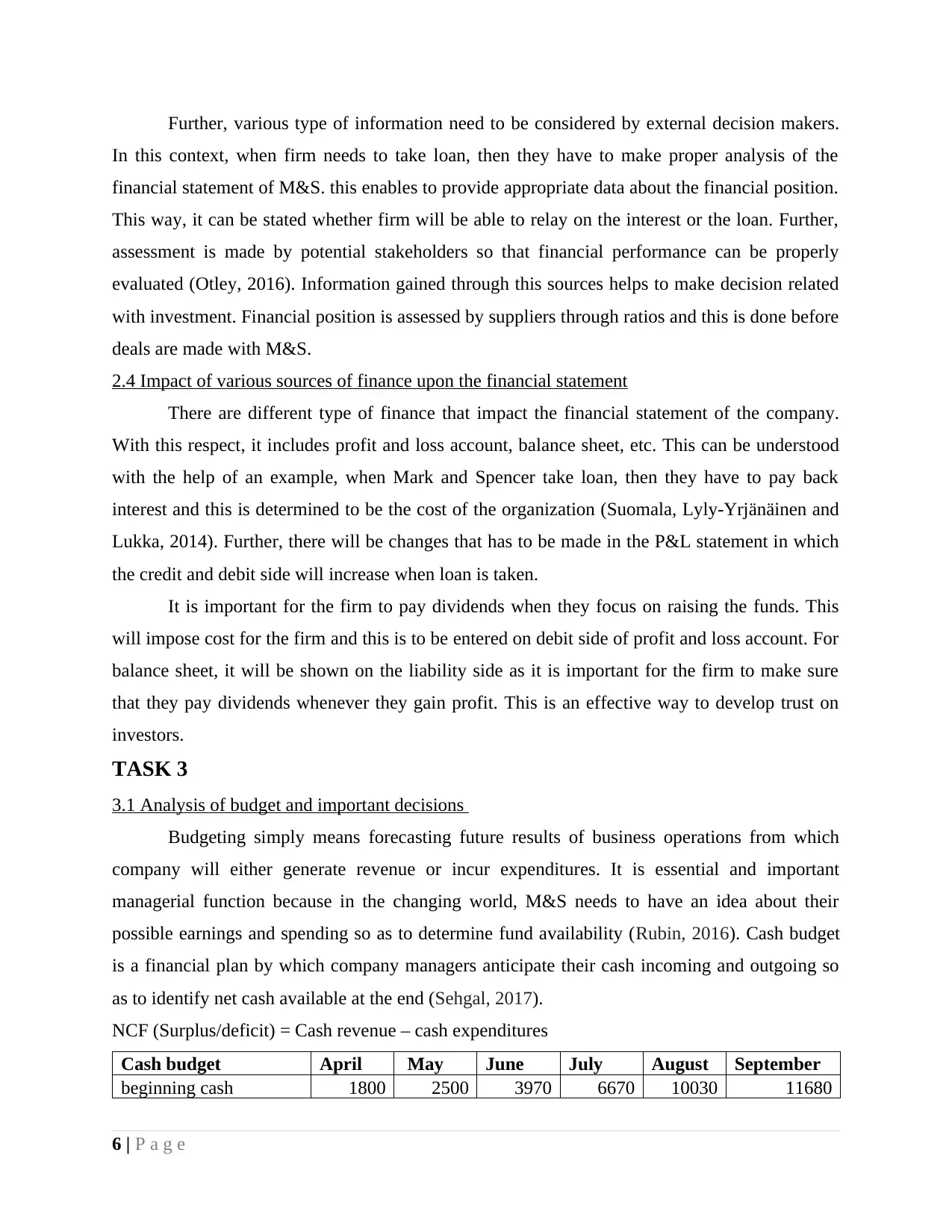
Further, various type of information need to be considered by external decision makers.
In this context, when firm needs to take loan, then they have to make proper analysis of the
financial statement of M&S. this enables to provide appropriate data about the financial position.
This way, it can be stated whether firm will be able to relay on the interest or the loan. Further,
assessment is made by potential stakeholders so that financial performance can be properly
evaluated (Otley, 2016). Information gained through this sources helps to make decision related
with investment. Financial position is assessed by suppliers through ratios and this is done before
deals are made with M&S.
2.4 Impact of various sources of finance upon the financial statement
There are different type of finance that impact the financial statement of the company.
With this respect, it includes profit and loss account, balance sheet, etc. This can be understood
with the help of an example, when Mark and Spencer take loan, then they have to pay back
interest and this is determined to be the cost of the organization (Suomala, Lyly-Yrjänäinen and
Lukka, 2014). Further, there will be changes that has to be made in the P&L statement in which
the credit and debit side will increase when loan is taken.
It is important for the firm to pay dividends when they focus on raising the funds. This
will impose cost for the firm and this is to be entered on debit side of profit and loss account. For
balance sheet, it will be shown on the liability side as it is important for the firm to make sure
that they pay dividends whenever they gain profit. This is an effective way to develop trust on
investors.
TASK 3
3.1 Analysis of budget and important decisions
Budgeting simply means forecasting future results of business operations from which
company will either generate revenue or incur expenditures. It is essential and important
managerial function because in the changing world, M&S needs to have an idea about their
possible earnings and spending so as to determine fund availability (Rubin, 2016). Cash budget
is a financial plan by which company managers anticipate their cash incoming and outgoing so
as to identify net cash available at the end (Sehgal, 2017).
NCF (Surplus/deficit) = Cash revenue – cash expenditures
Cash budget April May June July August September
beginning cash 1800 2500 3970 6670 10030 11680
6 | P a g e
In this context, when firm needs to take loan, then they have to make proper analysis of the
financial statement of M&S. this enables to provide appropriate data about the financial position.
This way, it can be stated whether firm will be able to relay on the interest or the loan. Further,
assessment is made by potential stakeholders so that financial performance can be properly
evaluated (Otley, 2016). Information gained through this sources helps to make decision related
with investment. Financial position is assessed by suppliers through ratios and this is done before
deals are made with M&S.
2.4 Impact of various sources of finance upon the financial statement
There are different type of finance that impact the financial statement of the company.
With this respect, it includes profit and loss account, balance sheet, etc. This can be understood
with the help of an example, when Mark and Spencer take loan, then they have to pay back
interest and this is determined to be the cost of the organization (Suomala, Lyly-Yrjänäinen and
Lukka, 2014). Further, there will be changes that has to be made in the P&L statement in which
the credit and debit side will increase when loan is taken.
It is important for the firm to pay dividends when they focus on raising the funds. This
will impose cost for the firm and this is to be entered on debit side of profit and loss account. For
balance sheet, it will be shown on the liability side as it is important for the firm to make sure
that they pay dividends whenever they gain profit. This is an effective way to develop trust on
investors.
TASK 3
3.1 Analysis of budget and important decisions
Budgeting simply means forecasting future results of business operations from which
company will either generate revenue or incur expenditures. It is essential and important
managerial function because in the changing world, M&S needs to have an idea about their
possible earnings and spending so as to determine fund availability (Rubin, 2016). Cash budget
is a financial plan by which company managers anticipate their cash incoming and outgoing so
as to identify net cash available at the end (Sehgal, 2017).
NCF (Surplus/deficit) = Cash revenue – cash expenditures
Cash budget April May June July August September
beginning cash 1800 2500 3970 6670 10030 11680
6 | P a g e
⊘ This is a preview!⊘
Do you want full access?
Subscribe today to unlock all pages.

Trusted by 1+ million students worldwide
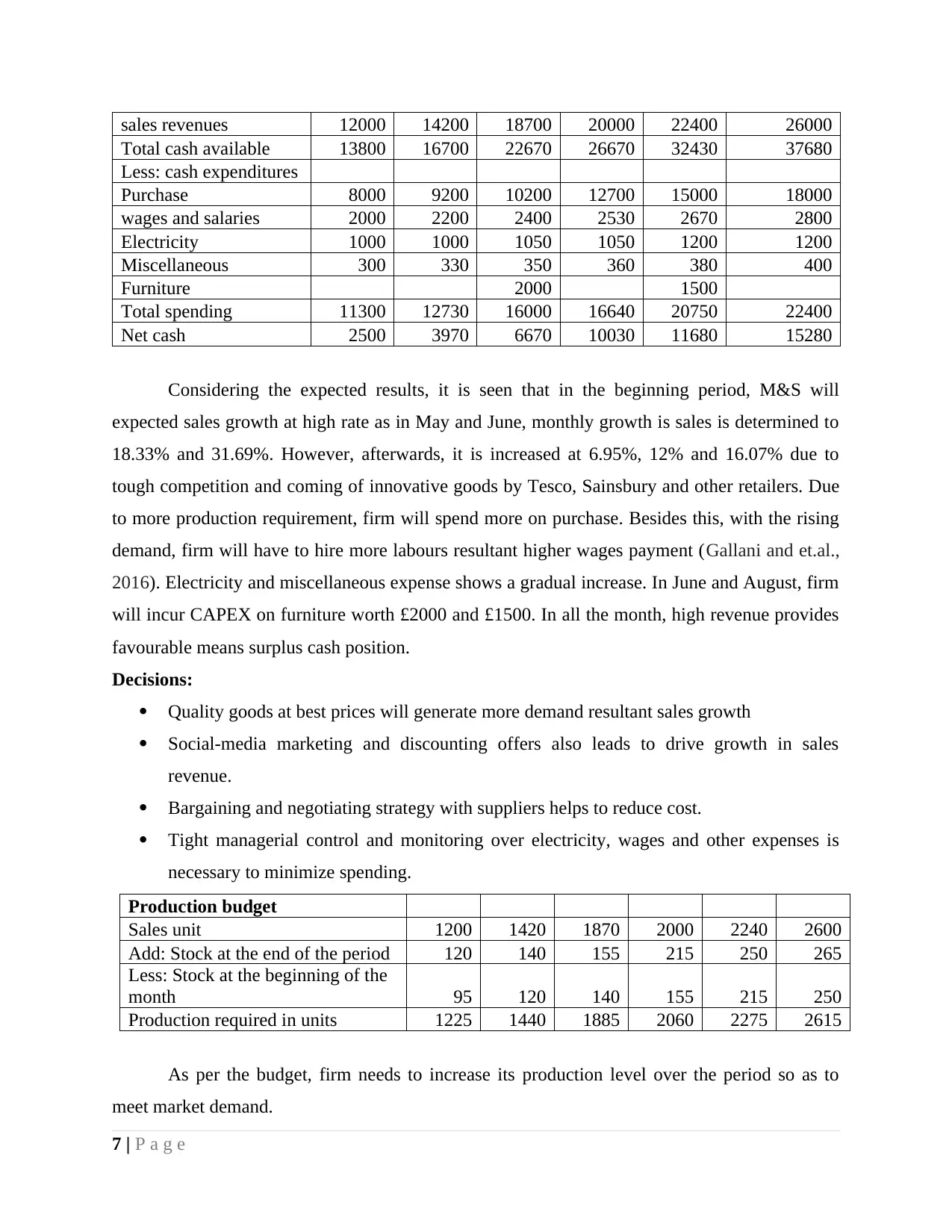
sales revenues 12000 14200 18700 20000 22400 26000
Total cash available 13800 16700 22670 26670 32430 37680
Less: cash expenditures
Purchase 8000 9200 10200 12700 15000 18000
wages and salaries 2000 2200 2400 2530 2670 2800
Electricity 1000 1000 1050 1050 1200 1200
Miscellaneous 300 330 350 360 380 400
Furniture 2000 1500
Total spending 11300 12730 16000 16640 20750 22400
Net cash 2500 3970 6670 10030 11680 15280
Considering the expected results, it is seen that in the beginning period, M&S will
expected sales growth at high rate as in May and June, monthly growth is sales is determined to
18.33% and 31.69%. However, afterwards, it is increased at 6.95%, 12% and 16.07% due to
tough competition and coming of innovative goods by Tesco, Sainsbury and other retailers. Due
to more production requirement, firm will spend more on purchase. Besides this, with the rising
demand, firm will have to hire more labours resultant higher wages payment (Gallani and et.al.,
2016). Electricity and miscellaneous expense shows a gradual increase. In June and August, firm
will incur CAPEX on furniture worth £2000 and £1500. In all the month, high revenue provides
favourable means surplus cash position.
Decisions:
Quality goods at best prices will generate more demand resultant sales growth
Social-media marketing and discounting offers also leads to drive growth in sales
revenue.
Bargaining and negotiating strategy with suppliers helps to reduce cost.
Tight managerial control and monitoring over electricity, wages and other expenses is
necessary to minimize spending.
Production budget
Sales unit 1200 1420 1870 2000 2240 2600
Add: Stock at the end of the period 120 140 155 215 250 265
Less: Stock at the beginning of the
month 95 120 140 155 215 250
Production required in units 1225 1440 1885 2060 2275 2615
As per the budget, firm needs to increase its production level over the period so as to
meet market demand.
7 | P a g e
Total cash available 13800 16700 22670 26670 32430 37680
Less: cash expenditures
Purchase 8000 9200 10200 12700 15000 18000
wages and salaries 2000 2200 2400 2530 2670 2800
Electricity 1000 1000 1050 1050 1200 1200
Miscellaneous 300 330 350 360 380 400
Furniture 2000 1500
Total spending 11300 12730 16000 16640 20750 22400
Net cash 2500 3970 6670 10030 11680 15280
Considering the expected results, it is seen that in the beginning period, M&S will
expected sales growth at high rate as in May and June, monthly growth is sales is determined to
18.33% and 31.69%. However, afterwards, it is increased at 6.95%, 12% and 16.07% due to
tough competition and coming of innovative goods by Tesco, Sainsbury and other retailers. Due
to more production requirement, firm will spend more on purchase. Besides this, with the rising
demand, firm will have to hire more labours resultant higher wages payment (Gallani and et.al.,
2016). Electricity and miscellaneous expense shows a gradual increase. In June and August, firm
will incur CAPEX on furniture worth £2000 and £1500. In all the month, high revenue provides
favourable means surplus cash position.
Decisions:
Quality goods at best prices will generate more demand resultant sales growth
Social-media marketing and discounting offers also leads to drive growth in sales
revenue.
Bargaining and negotiating strategy with suppliers helps to reduce cost.
Tight managerial control and monitoring over electricity, wages and other expenses is
necessary to minimize spending.
Production budget
Sales unit 1200 1420 1870 2000 2240 2600
Add: Stock at the end of the period 120 140 155 215 250 265
Less: Stock at the beginning of the
month 95 120 140 155 215 250
Production required in units 1225 1440 1885 2060 2275 2615
As per the budget, firm needs to increase its production level over the period so as to
meet market demand.
7 | P a g e
Paraphrase This Document
Need a fresh take? Get an instant paraphrase of this document with our AI Paraphraser
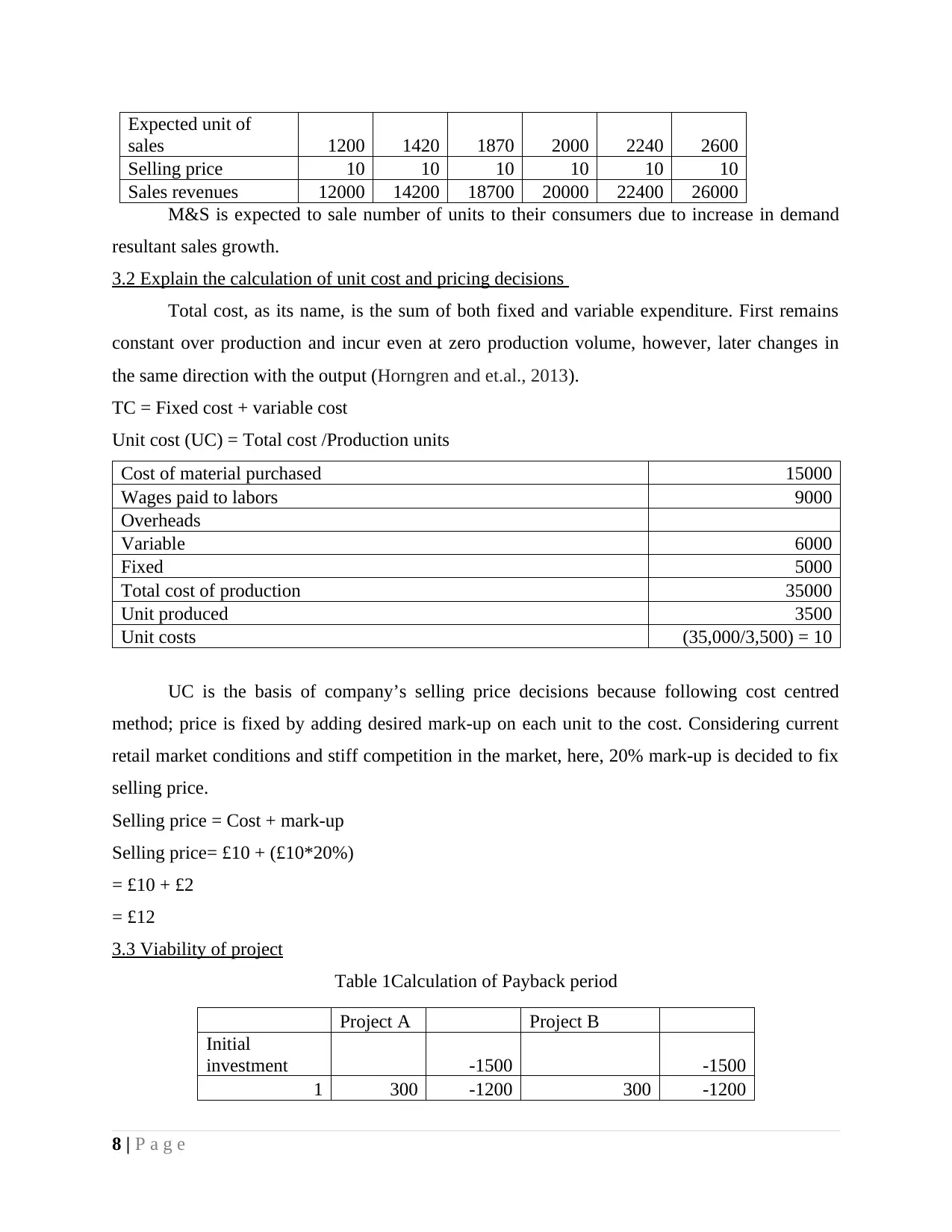
Expected unit of
sales 1200 1420 1870 2000 2240 2600
Selling price 10 10 10 10 10 10
Sales revenues 12000 14200 18700 20000 22400 26000
M&S is expected to sale number of units to their consumers due to increase in demand
resultant sales growth.
3.2 Explain the calculation of unit cost and pricing decisions
Total cost, as its name, is the sum of both fixed and variable expenditure. First remains
constant over production and incur even at zero production volume, however, later changes in
the same direction with the output (Horngren and et.al., 2013).
TC = Fixed cost + variable cost
Unit cost (UC) = Total cost /Production units
Cost of material purchased 15000
Wages paid to labors 9000
Overheads
Variable 6000
Fixed 5000
Total cost of production 35000
Unit produced 3500
Unit costs (35,000/3,500) = 10
UC is the basis of company’s selling price decisions because following cost centred
method; price is fixed by adding desired mark-up on each unit to the cost. Considering current
retail market conditions and stiff competition in the market, here, 20% mark-up is decided to fix
selling price.
Selling price = Cost + mark-up
Selling price= £10 + (£10*20%)
= £10 + £2
= £12
3.3 Viability of project
Table 1Calculation of Payback period
Project A Project B
Initial
investment -1500 -1500
1 300 -1200 300 -1200
8 | P a g e
sales 1200 1420 1870 2000 2240 2600
Selling price 10 10 10 10 10 10
Sales revenues 12000 14200 18700 20000 22400 26000
M&S is expected to sale number of units to their consumers due to increase in demand
resultant sales growth.
3.2 Explain the calculation of unit cost and pricing decisions
Total cost, as its name, is the sum of both fixed and variable expenditure. First remains
constant over production and incur even at zero production volume, however, later changes in
the same direction with the output (Horngren and et.al., 2013).
TC = Fixed cost + variable cost
Unit cost (UC) = Total cost /Production units
Cost of material purchased 15000
Wages paid to labors 9000
Overheads
Variable 6000
Fixed 5000
Total cost of production 35000
Unit produced 3500
Unit costs (35,000/3,500) = 10
UC is the basis of company’s selling price decisions because following cost centred
method; price is fixed by adding desired mark-up on each unit to the cost. Considering current
retail market conditions and stiff competition in the market, here, 20% mark-up is decided to fix
selling price.
Selling price = Cost + mark-up
Selling price= £10 + (£10*20%)
= £10 + £2
= £12
3.3 Viability of project
Table 1Calculation of Payback period
Project A Project B
Initial
investment -1500 -1500
1 300 -1200 300 -1200
8 | P a g e

2 400 -800 500 -700
3 600 -200 500 -200
4 300 100 400 200
5 500 600 400 600
Table 2Calculation of ARR
Project
A Project B
Initial investment 1500 1500
1 300 300
2 400 500
3 600 500
4 300 400
5 500 400
Total 2100 2100
Average 525 420
ARR 35.00% 28.00%
Table 3Calculation of NPV
Project A
Pv @
10% Present value Project B PV @ 10%
Present
value
Initial
investment 1500 1500
1 300 0.909 273 300 0.909 272.73
2 400 0.826 331 500 0.826 413.22
3 600 0.751 451 500 0.751 375.66
4 300 0.683 205 400 0.683 273.21
5 500 0.621 310 400 0.621 248.37
Total 1569 1583
NPV 69 83.18
Table 4Calculation of IRR
Project A Project B
Initial
investment -1500 -1500
1 300 300
2 400 500
3 600 500
4 300 400
9 | P a g e
3 600 -200 500 -200
4 300 100 400 200
5 500 600 400 600
Table 2Calculation of ARR
Project
A Project B
Initial investment 1500 1500
1 300 300
2 400 500
3 600 500
4 300 400
5 500 400
Total 2100 2100
Average 525 420
ARR 35.00% 28.00%
Table 3Calculation of NPV
Project A
Pv @
10% Present value Project B PV @ 10%
Present
value
Initial
investment 1500 1500
1 300 0.909 273 300 0.909 272.73
2 400 0.826 331 500 0.826 413.22
3 600 0.751 451 500 0.751 375.66
4 300 0.683 205 400 0.683 273.21
5 500 0.621 310 400 0.621 248.37
Total 1569 1583
NPV 69 83.18
Table 4Calculation of IRR
Project A Project B
Initial
investment -1500 -1500
1 300 300
2 400 500
3 600 500
4 300 400
9 | P a g e
⊘ This is a preview!⊘
Do you want full access?
Subscribe today to unlock all pages.

Trusted by 1+ million students worldwide
1 out of 21